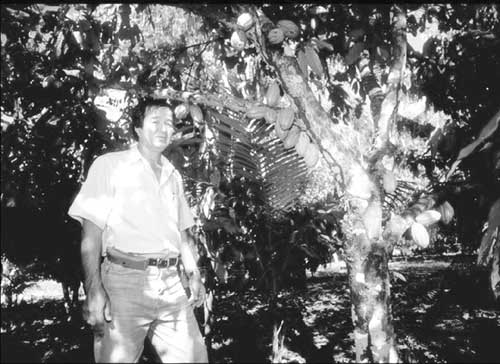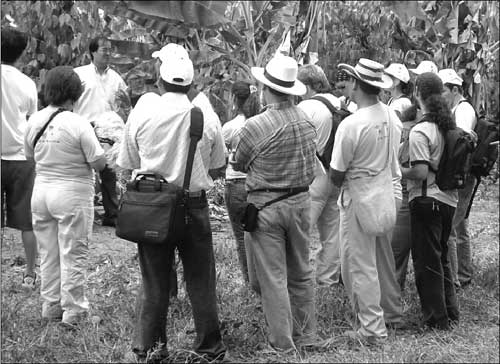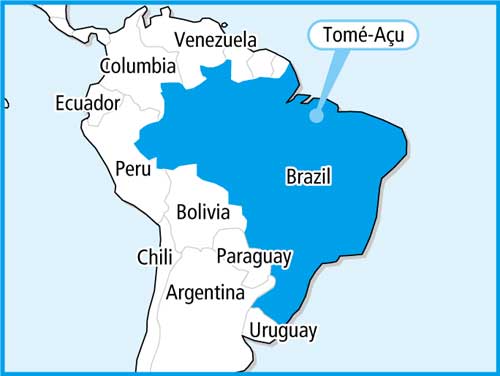Japan's Official Development Assistance White Paper 2008
—The Wisdom of Japan to Protect Agriculture with Agroforestry in the Amazon—
The year of 2008 marked the 100th anniversary of the Japanese immigration to Brazil. Presently in Brazil, there are approximately 1.5 million Japanese-Brazilians, who account for more than half of Japanese descendants worldwide. Commemorative events have been held in both countries to mark the 100th anniversary, further deepening the friendly relations between Japan and Brazil.
As the Japanese immigrants progressed into various locations in Brazil, some of them established settlements in the Amazon River basin. In 1929, the Japanese immigration reached Tomé-Açu, located inland approximately 230km south of Belem in the State of Para, at the mouth of the Amazon River. People in Tomé-Açu originally engaged in horticulture of mainly rice and vegetables. In the 1950s, the pepper, which was introduced from Asia to their region, became highly popular there. Some became successful in growing pepper and built gorgeous mansions, or "pepper castles." However, a blight, which spread within the region in the 1960s, caused devastating damage to Tomé-Açu. Mr. Michinori Konagano, who immigrated to Tomé-Açu from Kagoshima Prefecture in Japan at the age of two, now works for the agricultural bureau in Tomé-Açu. "The entire crop of 2,000 pepper plants was destroyed. My family decided to go back to Japan and began preparations to leave. However, we ended up staying because we couldn't sell our land. Also, I dropped out of elementary school after the fifth grade; it was very difficult for us," he recollects. The following years, Mr. Konagano devoted his utmost to making the best out of a difficult situation.

Mr. Konagano under a cacao tree. He works hard to popularize agroforestry. (Photograph: Hikaru Nagatake)
His life began to change around 1980, when he heard a story about the "Three-Track Approach" from a Japanese agricultural expert. "I learned that if you plant three rows of anything, they can't be knocked down as easily. I was convinced I had found a solution. So, I started planting a variety of crops—pepper, cacao, passion fruits—in my fields" he says. This style of agriculture, where various crops are planted together, is now known as 'agroforestry,' or an effective environmental preservation method. However, the agroforestry couldn't truly flourish, with various failures in the first 10 years. He gradually established appropriate methods through trial and error.
The Government of Japan, through Japan International Cooperation Agency (JICA), transferred agricultural techniques to the Japanese immigrants in Tomé-Açu and carried out research cooperation on agroforestry with the Brazilian Agricultural Research Corporation (EMBRAPA1). In FY2006, JICA launched the Third Country Training Program with EMBRAPA to host seminars to expand agroforestry skills to neighboring countries such as Venezuela, Colombia, Ecuador, Peru, and Bolivia. These seminars fixedly include a visit to his agroforestry fields in Tomé-Açu, which is part of the seminar's fixed schedule, and provides a valuable opportunity for trainees from various countries to learn from the region' s success in agroforestry.
Mr. Konagano devotes himself to promoting agroforestry for augmenting the level of agricultural skills in Tomé-Açu. He began sharing seeds with neighboring farmers since almost 15 years ago and now hosts seminars in various locations upon invitation. Hoping to transfer Tomé-Açu's experience to other South and Central American countries and even as far as Africa, Mr. Konagano dedicates his life everyday to spreading agr ofor estry techniques.

Third Country Training Program (TCTP): Mr. Konagano giving a lecture on agroforestry


 Next Page
Next Page